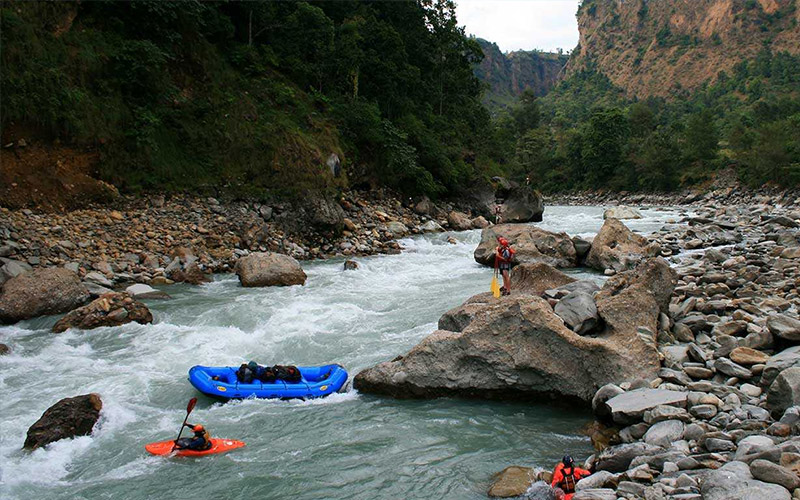Welcome to the land of the majestic Himalayas, where adventure awaits at every bend of the river. The White Water Rafting Tour Nepal Himalayas offers an adrenaline-pumping experience like no other. From serene river sections perfect for beginners to challenging rapids that will test even the most seasoned adventurers, Nepal has it all.
If you're a thrill-seeker looking to explore nature's raw power while being captivated by breathtaking scenery, this article is for you. We'll take you through a comprehensive outline, covering essential aspects of white water rafting in Nepal's Himalayas. So, grab your life jacket, paddle, and adventurous spirit as we embark on this thrilling journey together.
The Magic of Nepal's Rivers
Nepal is a country blessed with an extensive network of rivers, making it a mecca for white water rafting enthusiasts. The Trishuli River, the Bhote Koshi River, and the Sun Koshi River are just a few of the iconic names that draw adventurers from all corners of the globe.
The Trishuli River: Adventurous Playgrounds
The Trishuli River is a fantastic choice for both beginners and seasoned rafters. Its rapids vary from class II to class IV, offering a perfect blend of excitement and scenic beauty. As you navigate the rapids, you'll pass through charming villages, terraced fields, and lush forests.
The Bhote Koshi River: A Surge of Adrenaline
For those seeking a heart-pounding experience, the Bhote Koshi River is the ultimate thrill. With continuous rapids ranging from class IV to V, this river will push your limits and test your skills. The breathtaking gorges and rugged landscapes add to the thrill of the adventure.
The Sun Koshi River: The Ultimate Expedition
Known as the "River of Gold," the Sun Koshi River offers an extended expedition that lasts for several days. This challenging journey takes you through remote regions of Nepal, allowing you to immerse yourself in its rich culture while tackling exhilarating rapids.
Best Time for Rafting in Nepal
To make the most of your white water rafting experience in the Nepal Himalayas, timing is crucial.
Spring: March to May
Spring is the most popular time for rafting in Nepal. The rivers are fed by the melting snow from the mountains, providing ideal water levels for an exciting adventure. The lush vegetation and blooming flowers add charm to the already mesmerizing surroundings.
Monsoon: June to August
The monsoon season brings heavy rainfall, which significantly increases the water levels in the rivers. While this may not be the best time for beginners, experienced rafters can take on the challenge of the swollen rapids, experiencing the full force of nature.
Autumn: September to November
The autumn season is another excellent time for rafting. The skies are clear, and the water levels are still suitable for a thrilling ride. The crisp air and clear views of the snow-capped Himalayan peaks create an unforgettable experience.
Winter: December to February
Winter brings colder temperatures, and the water levels decrease, making it less favorable for rafting. However, if you're up for a more relaxed and less crowded adventure, some sections of the rivers are still open for rafting during this time.
Choosing the Right Rafting Company
Selecting a reputable and experienced rafting company is essential for a safe and enjoyable experience.
Safety First: Guides and Equipment
Ensure the company you choose has certified and experienced guides who are well-versed in river navigation and safety protocols. Check if they provide proper safety equipment, including helmets, life jackets, and rescue gear.
Experience and Expertise
Look for companies with a proven track record in organizing rafting tours in Nepal. Read reviews and testimonials from previous clients to gauge their reliability and expertise.
River Ratings and Difficulty Levels
Different rivers offer varying degrees of difficulty. Make sure the company can match your skill level with the appropriate river and rapid class.
Environmental Responsibility
Opt for companies that prioritize environmental conservation and follow Leave No Trace principles. Rafting should be an eco-friendly adventure that respects nature and local communities.
Preparing for Your Adventure
Congratulations, you've chosen the perfect rafting company! Now, it's time to prepare for your thrilling adventure.
Physical Fitness and Health
White water rafting can be physically demanding. Ensure you are in good health and have a moderate level of fitness before embarking on this adventure.
Essential Gear
The rafting company should provide most of the necessary gear, but you should bring your personal items like swimwear, quick-drying clothing, sunscreen, and a hat.
Training and Safety Briefing
Before setting out, your guides will provide essential training and a safety briefing to familiarize you with paddling techniques and what to do in different situations.
Respect Local Customs and Cultures
As you travel through Nepal, respect the local customs and cultures. Embrace the unique traditions and show appreciation for the hospitality of the local communities.
In the Rapids: Navigating the Journey
Finally, the day has arrived. You're geared up, prepared, and filled with excitement.
The Thrill of Adrenaline
As you hit the first rapid, you'll feel the surge of adrenaline coursing through your veins. The roar of the water and the thrill of overcoming each obstacle will leave you exhilarated.
Embracing Teamwork
Rafting is not a solo adventure. It's a journey of teamwork, where everyone's synchronization and communication are vital to navigate the rapids successfully.
Appreciating Nature's Beauty
Amidst the adrenaline rush, don't forget to pause and take in the stunning landscapes around you. The Himalayas' grandeur, lush greenery, and crystal-clear waters will leave you in awe.
Riverbank Camping and Bonfires
Many multi-day rafting trips include camping by the riverbanks. Enjoy evenings under the stars, share stories around bonfires, and create memories that will last a lifetime.
Frequently Asked Questions
Is white water rafting in Nepal safe for beginners?
Yes, Nepal offers rivers suitable for beginners with class II and III rapids, providing an exciting yet safe experience.
